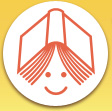Preschool – Kindergarten (Annick Press, 2012)
Charmingly appropriate is the idea that a board book, or in this case two, would be created around one of the first words that toddlers learn – up.
Up Dog follows Dog through a straight-forward, yet eventful, kind of day. Hazel Hutchins uses 40 words to describe how Dog digs up a bone in the yard and then manages to muddy up the entire house. The dog is penned up while the owner cleans up, wipes up and hangs up the washing to dry. At this point, Dog is then free to race up and back into the house. After Dog too is cleaned, the story ends with it enfolded in its owner’s loving arms. Eyes closed, Dog snuggles up soundly.
While Hutchins has accomplished the almost impossible task of laying out a complete story in such few words, Quebec illustrator, Fanny has also performed the impressive task of creating a pictorial foundation that allows the story to flow smoothly without seeming to jump or jar. Her illustrations pair perfectly with the text, appealing to young readers with bright but simple backgrounds and also ensuring that key elements pop directly into focus.
In both Up Cat and Up Dog, the expressions on the animals’ faces contribute much to the story. In one particularly evocative illustration, Dog perks up, displaying puppy-dog eyes and a wagging tail that foreshadow the happy ending that is certain to follow. In a similar manner, Cat’s expressions reveal the further meanings behind its actions, such as when Cat is being haughty or sneakily “up to no good.” Dog even makes a brief appearance in the pictures for Up Cat, sneaking up on Cat as it is washing up and prompting Cat to “puff up” with an arched back and wide eyes.
Up Cat may not involve as much drama as Dog’s story, but perhaps this is in keeping with the protagonist’s character. Cat moves through its day, lapping up milk, leaping up on furniture and curling up in the sun. It does get into trouble, ripping up a ball of yarn, and accidentally finding itself scrunched up in a box, and is eventually lifted up onto a window sill and out of harm’s way, but the same story arc or connection between cause and effect doesn’t feel as apparent in this book.
While these books are simple enough to engage audiences as young as 2, they are also appropriate for beginning readers in Kindergarten. Up is one of the first words young children say and it is also an appropriate first word for them to read. These companion books are sure to appeal to both “cat people” and “dog people” alike.
Review originally published in Canadian Children’s Book News, Summer 2012

